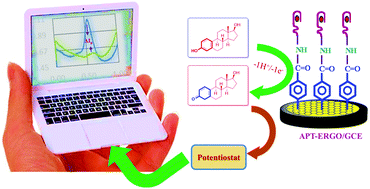Graphene-amplified femtosensitive aptasensing of estradiol, an endocrine disruptor†
Abstract
We report the construction of a novel electrochemical femtomolar aptasensing APT–ERGO/GCE interface based on the covalent immobilization of 38-mer amine-functionalized (NH2–APT) 17β-estradiol (E2) DNA aptamers on a graphene amplifying platform. Graphene oxide (GO) was synthesized and characterized by using FTIR, UV-vis spectroscopy, XRD spectroscopy, and SEM technique. The strategy for the construction of the E2-aptasensing interface involves in a three-step modification process. (i) First, we carried out the electrochemical reduction of GO on the GCE electrode to form ERGO/GCE. (ii) Then, as an impact strategy, the E2-aptamers (NH2–APT) were further immobilized on the surface of the ERGO/GCE interface through electrochemical reduction of surface-functionalized diazonium salts. This step includes electrografting of ERGO/GCE by electrochemical reduction of the diazonium salt (ClN2+–Ph–COOH) to obtain the ERGO/GCE–Ph–COOH-modified electrode. (iii) Finally, the free carboxyl groups on the ERGO/GCE–Ph–COOH surface were conjugated with NH2–APT through formation of carbodiimide to afford an aptasensing APT–ERGO/GCE interface. The presence of ERGO as an amplifying platform led to the successful immobilization of E2-aptamers with a surface coverage of 1.9 × 1013 molecule per cm2, which is higher than the values obtained in other reported methods. The constructed aptasensing APT–ERGO/GCE interface was appraised using cyclic voltammetry (CV) and electrochemical impedance spectroscopy (EIS). The synergetic effect of high affinity and specificity of E2-aptamers and graphene platform was beneficial for the novel femtosensitive label-free electrochemical aptasensing APT–ERGO/GCE interface for the detection of [E2]. The oxidation current peaks at the aptasensing APT–ERGO/GCE interface were proportional to [E2] over two different concentration linearity ranges 1.0 × 10−15 mol L−1–9.0 × 10−12 mol L−1–1.2 × 10−11 mol L−1 to 2.3 × 10−10 mol L−1 with a limit of detection (LOD) of 0.5 × 10−15 mol L−1. This aptasensing APT–ERGO/GCE interface was employed as a femtomolar tool for the determination of [E2] in the environmental and pharmaceutical samples such as wastewater (spiked) and pharmaceutical dosages.

- This article is part of the themed collection: Analyst Recent HOT articles


 Please wait while we load your content...
Please wait while we load your content...